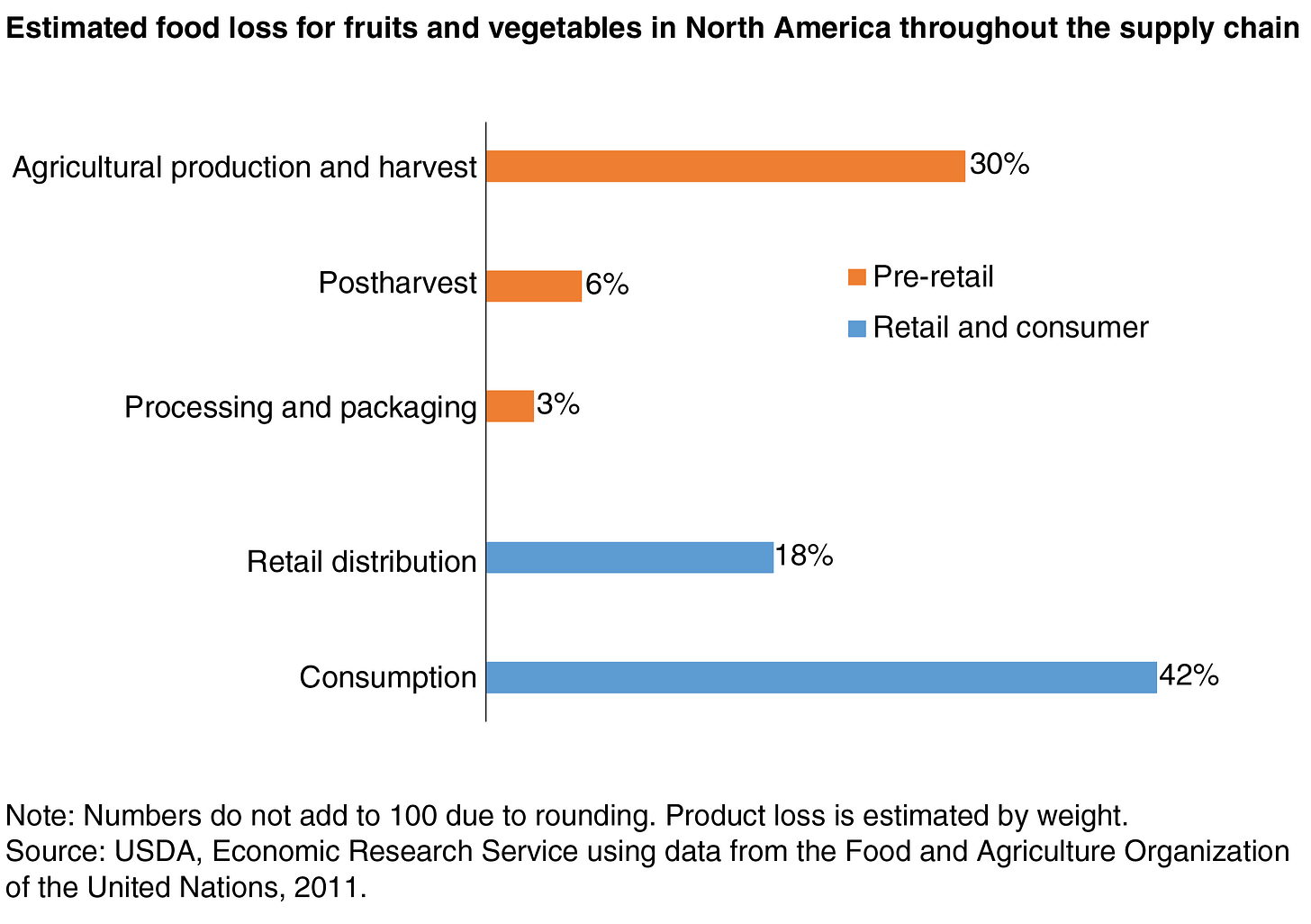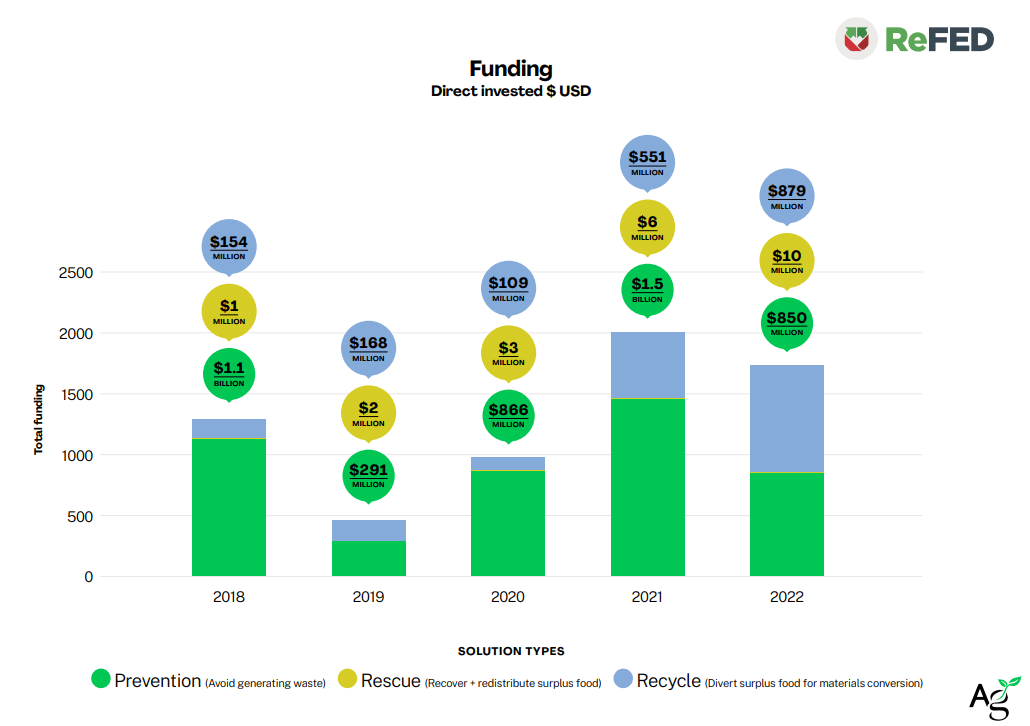Key Takeaways:
- Global Food Waste Crisis: Food waste is a critical global issue with severe implications for the environment, economy, and society, with significant losses occurring at multiple stages of the food supply chain.
- Economic and Environmental Costs: In the UK, food waste on farms results in £1.8 billion in lost profitability, while in the US, 30% of the food supply is wasted annually, amounting to a $218 billion loss.
- Technological Innovations: Agri-tech companies are developing innovative solutions to reduce food waste, such as upcycling food waste into valuable resources and extending the shelf life of produce.
- Government Initiatives: Governments worldwide, including the EU, US, India, and Rwanda, are implementing strategic policies and investments to reduce food waste, focusing on improving infrastructure, promoting sustainability, and supporting innovation.
- Challenges and Path Forward: Despite these efforts, significant challenges remain, including infrastructure deficits, cultural and behavioral patterns, and technological adoption barriers. A collaborative effort is required to overcome these challenges and move towards a more sustainable food system.
Food Waste: Facts & Figures
In the United Kingdom, agricultural waste represents a significant loss of resources and potential income for farmers. Approximately 25% of waste occurs on farms, translating to a staggering £1.8 billion in lost profitability, according to WWF’s report. If addressed, this could potentially increase the profitability of UK farms by up to 20%. This issue is not just about improving the bottom line; it’s about enhancing the efficiency of food production and reducing unnecessary waste with broader environmental impacts.
Across the Atlantic, the United States faces a similar challenge with food waste. It’s estimated that 30% of the country’s food supply is wasted yearly, according to the USDA ERS report in 2020. This represents a loss of $218 billion from the $1.264 trillion agriculture industry, according to RTS. Such figures highlight a systemic issue within the food supply chain, where vast resources are expended to produce food that never reaches the consumer. Addressing this could improve food security and reduce the environmental footprint of agriculture.

Globally, the agriculture industry is valued at $13.4 trillion as of 2023. The World Wildlife Fund (WWF) estimates that 20-40% of agricultural production is wasted. The United Nations Food and Agriculture Organization (FAO) provides a more granular view, estimating that 14% of food is wasted post-harvest and up to the retail level, not including retail losses. Additionally, 10% of waste occurs during the growth phase, which can fluctuate with seasonality, and another 5-10% is lost during harvest, which also varies.
The causes of this waste are multifaceted. Price volatility can lead to crops being left unharvested if market prices fall below the cost of harvest and distribution. Labor costs and availability are also critical factors; crops can go unharvested without sufficient labor, or care in handling and storage can be compromised, leading to spoilage. Inadequate infrastructure, particularly in developing countries, can result in significant post-harvest losses. Aesthetic standards imposed by retailers and over-regulation can also lead to perfectly edible food being discarded.
While it’s acknowledged that certain factors leading to the global food waste are inherent to agricultural processes—such as natural disasters, extreme weather conditions, and disease outbreaks—there remains substantial scope for reduction. Advancements in agricultural technology, such as adopting genetically modified seeds and utilizing controlled environment agriculture, have demonstrated the potential to minimize waste. Moreover, innovative strategies are continually being developed to repurpose what waste does occur, turning it into bioenergy or compost, thereby contributing to a circular economy. Recognizing that a zero-waste scenario is impractical, our focus shifts to these resourceful methods of waste minimization and reutilization, underscoring our commitment to sustainable food systems and our resilience in the face of inevitable challenges.
Companies Working On Reducing Food Waste*

Agricultural technology is burgeoning, with dynamic companies attracting significant investments to propel their innovative solutions forward. Kern Tech, for instance, has completed a Series A funding round, amassing 12 million euros. Their focus is on escalating the production and commercialization of sustainable ingredients crafted from upcycled stone fruit pits—turning what would be waste into valuable resources.
Bene-Bono, a French enterprise, has garnered 8.8 million euros to expand its operations across Europe. The company partners with farmers to salvage and sell produce that would otherwise be rejected by retailers due to stringent aesthetic standards, thus reducing waste and supporting local agriculture.
In the quest to prolong the shelf life of food, Strella Biotechnology and It’s Fresh! are making significant advances, a crucial endeavor in diminishing food spoilage. Fieldworks Robotics has also raised 1.7 million euros to combat labor shortages within horticulture through automation—a testament to the sector’s adaptation to advanced technologies to overcome persistent challenges.
Companies engaged in Controlled Environment Agriculture (CEA) lead the charge against food waste at the production level by fine-tuning resource utilization. This strategy bolsters efficiency and reinforces the sustainability of the agri-food supply chain. For example, Better Origin (Entonics) is converting organic waste into animal feed, and EcoCeres is repurposing it into biofuel, epitomizing the principles of a circular economy. Additionally, BioVeritas’s impressive $65 million investment spotlights the promise of using fermentation processes to transform waste into premium, clean-label ingredients, underscoring a robust commitment to sustainability and innovation within the sector.
*Not every company has been listed here, as dozens of companies worldwide are working on reducing food waste at every level.
Government Initiatives To Tackle Food Waste
Governments worldwide are increasingly recognizing the critical issue of food waste at the production level and are implementing various strategies to tackle it. In the European Union, the Farm to Fork Strategy, part of the European Green Deal, aims to make food systems fair, healthy, and environmentally friendly. This strategy includes actions to halve per capita food waste at the retail and consumer levels and reduce food losses along the production and supply chains by 2030. The EU also supports the development of a market for ‘green’ products and has funded research and innovation in food waste reduction.
In the United States, the USDA and EPA have set a goal to reduce food waste by 50% by 2030. This ambitious target is being approached through public-private partnerships, with the government providing grants for organizations that innovate in food waste reduction and management. The U.S. Food Loss and Waste 2030 Champions program is one such initiative that encourages businesses and organizations to make a public commitment to reduce food waste in their operations.
Emerging economies are also stepping up their efforts. For instance, India has launched schemes like the Pradhan Mantri Kisan Sampada Yojana (PMKSY) with components focusing on modernizing the supply chain infrastructure to reduce food waste and loss. The government has also been promoting solar-powered cold storage solutions in rural areas to help farmers keep their produce fresh for longer, thereby reducing post-harvest losses.
Countries like Rwanda have implemented post-harvest handling and storage practices in Africa as part of their strategic plan to transform agriculture. The government has invested in post-harvest infrastructure, including constructing modern storage facilities and providing drying equipment to prevent losses caused by improper handling and storage. These interventions are crucial in a continent where a significant portion of food waste occurs during production and post-harvest stages due to inadequate infrastructure and technology. Through these varied approaches, governments worldwide are taking significant steps to address the challenge of food waste at the production level, aiming to improve food security and reduce environmental impact.
Tackling Global Food Waste: Challenges Ahead
The journey towards significant food waste reduction is fraught with social, economic, and technological challenges. One of the primary hurdles is the lack of infrastructure, especially in developing countries, where the means for efficient harvesting, storing, and transporting food are often inadequate. This leads to substantial food spoilage before it even reaches the market. Investment in cold storage facilities, improved transportation networks, and better market access can help mitigate these losses, but these require substantial capital and policy support.
Another challenge is the cultural and behavioral aspects of food waste. In many societies, there is a lack of awareness about the scale and impact of food waste. This is compounded by ingrained habits, such as over-purchasing or valuing aesthetics over quality in food, leading to discarded perfectly edible food. Changing consumer behavior is a slow and complex process that requires targeted education campaigns, changes in retail practices, and perhaps even shifts in social norms regarding food consumption and value.
Technological innovation, while a part of the solution, also presents its own set of challenges. Developing and deploying new technologies that can extend the shelf life of food, improve supply chain efficiency, or transform waste into energy or other resources requires creativity and significant investment. Moreover, adopting such technologies can be hindered by a lack of technical expertise or resistance to change among farmers and food producers, particularly in traditional farming communities.
Policy and regulation also play a critical role in addressing food waste, yet creating and implementing effective policies is a complex task that must balance economic, environmental, and social factors. Policymakers must navigate the interests of multiple stakeholders, including farmers, businesses, and consumers, to create incentives and regulations that reduce waste without burdening any single group. Furthermore, global food supply chains mean that efforts to reduce food waste must be coordinated across borders, adding a layer of complexity to policy-making.
Concluding Notes
In conclusion, the facts and figures surrounding food waste paint a picture of a global challenge with significant implications for economic stability, environmental sustainability, and food security. The United Kingdom and the United States, among other nations, face substantial losses in their agricultural sectors due to inefficiencies leading to waste. These losses represent missed economic opportunities and a considerable environmental burden.
Innovative companies and startups are stepping up to address this issue, leveraging technology and new business models to reduce waste across the food supply chain. From extending the shelf life of produce to transforming waste into valuable resources, these companies are at the vanguard of a movement towards a more sustainable and efficient food system.
Government initiatives play a pivotal role in catalyzing and supporting these efforts with strategies and policies to reduce food waste from the farm to the consumer. Infrastructure, research, and development investments, along with regulatory reforms, are essential components of a comprehensive approach to this issue.
However, the path ahead is not without its challenges. Infrastructure deficits, cultural and behavioral patterns, technological adoption barriers, and the complexities of policy-making all present obstacles to reducing food waste. Addressing these challenges will require a concerted and collaborative effort from all stakeholders, from policymakers and industry leaders to consumers and communities. With continued dedication and innovation, significant strides can be made toward a future where food waste is no longer a burden but a problem of the past.



7 Comments